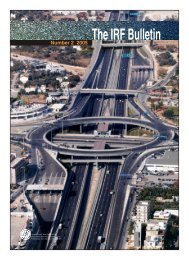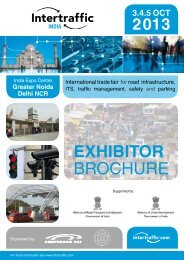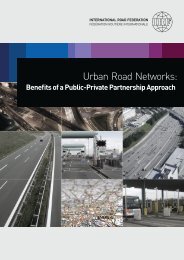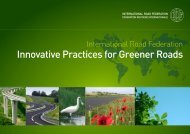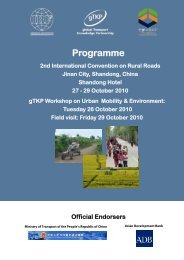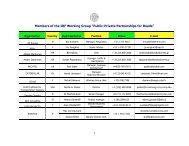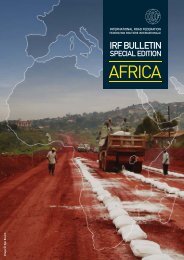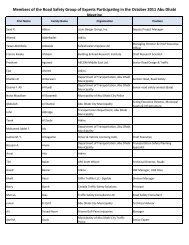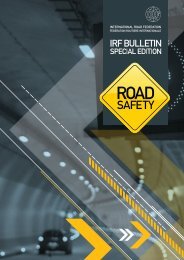Download - IRF | International Road Federation
Download - IRF | International Road Federation
Download - IRF | International Road Federation
You also want an ePaper? Increase the reach of your titles
YUMPU automatically turns print PDFs into web optimized ePapers that Google loves.
MATERIALS FOR ASIAN ROADS<br />
MATERIALS FOR ASIAN ROADS<br />
There are historical reasons for the use of pure bitumen, rather than emulsions, on Asian roads. But things are<br />
changing and emulsions are coming into their own. Part of the change will involve the use of waste products<br />
from other industries.<br />
Bitumen emulsions in India:<br />
past, present and future<br />
Étienne le Bouteiller<br />
Technical & Development <strong>International</strong><br />
Manager, Colas SA<br />
A short history: bitumen emulsion is not a new<br />
technique in India. Some uses that date to the 1930s<br />
have even been reported. However, the technique could<br />
not attain the position it should have had, from that time<br />
onwards. The competition of hot bitumen associated with<br />
traditional uses has been predominant for a long time.<br />
At the beginning of the 1990s, reported annual volumes<br />
were in the range of 10 to 20,000 tonnes, produced by<br />
several small plants that could not afford to acquire the<br />
real knowledge that could have helped to update the<br />
technique. For that reason, bitumen emulsion suffered<br />
from a poor reputation.<br />
With the development of the internal market boosted by<br />
the authorities' willingness to improve road infrastructure,<br />
some big players started reconsidering developments<br />
using the technique. In this respect, Indian Oil<br />
Corporation and Hindustan Petroleum Corporation Ltd<br />
started up emulsion factories close to the main markets,<br />
such as Delhi, Mumbai and Chennai.<br />
Along with such new developments, technologies from<br />
abroad were introduced and the standards were updated<br />
in such a way that the technique could be implemented<br />
within a suitable and accepted framework.<br />
Current use: for the past 10 years, the development of<br />
bitumen emulsions has been the result of three factors:<br />
the introduction of modern techniques by the local and<br />
powerful oil industry, supported by international players;<br />
the development of the road network, and especially the<br />
"Golden Quadrilateral", followed by the North-South and<br />
East-West corridors; acceptance and support by pre-<br />
eminent bodies such as the Indian <strong>Road</strong>s Congress,<br />
Central <strong>Road</strong> Research Institute and the National Highway<br />
Authority of India.<br />
All this has boosted the emulsion consumption in India<br />
from only 15,000 tons in 1993 to more than 170,000 in<br />
2007. The main uses for bitumen emulsions are tack<br />
coats and prime coats. Other uses are emerging, such as<br />
surface rejuvenation, cold mixes and micro surfacing.<br />
Surface dressing is not used to a large extent. Bitumen<br />
emulsions are governed by the IS 8887-95 standard. This<br />
standard is regularly revised, in order to extend the use of<br />
emulsions.<br />
The future: in 2007, the volume ratio of emulsion to<br />
bitumen was 3.6%. As the average worldwide value of<br />
this index is 9%, one can expect a tremendous increase in<br />
emulsion consumption in the years to come-of up to<br />
more than 400,000 tons. In fact, such a volume may be<br />
seen as a minimum, especially when considering the<br />
existing Indian road network, and especially the rural<br />
roads, that account for 2.7 million kilometres.<br />
<strong>IRF</strong> BULLETIN SPECIAL EDITION : ASIA & OCEANIA<br />
10



